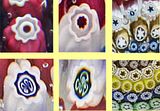***
Hi Roy.
Good question! I suppose that if an item emerges from the Whitefriars factory, with Whitefriars label, sold by Whitefriars, then it would legally be a Whitefriars piece. But as you say, what if it was made by an ex-Walsh Walsh worker, using Walsh Walsh canes...a purist would feel the parentage was Walsh Walsh, no doubt.
I think there is quite a lot of evidence to suggest that Whitefriars used Walsh Walsh canes - or at least Walsh Walsh workers to make their canes - in the early 1950s. The image below shows (left and middle columns) close-ups of four canes from Whitefriars EIIR paperweights, and canes from later Whitefriars paperweights on the right, which are quite distinct in design. The red cane top left and one ring in the bottle we were debating are very similar, and are surely from the same source. The bottom left and centre canes clearly owe much to the Walsh Walsh '7/6' cane process (of folding two colours of glass together to get the design), yet appear in a Whitefriars paperweight. I suspect these bottles were made at Whitefriars, quite possibly by ex Walsh Walsh workers who used some Walsh Walsh canes in them, and maybe before the 1951 paperweights.
The base of my bottle has a thin foot rim, and is polished concave - but as it is not a paperweight, and is probably an early piece, that is not too surprising. I wish these people had kept better records!
Alan
